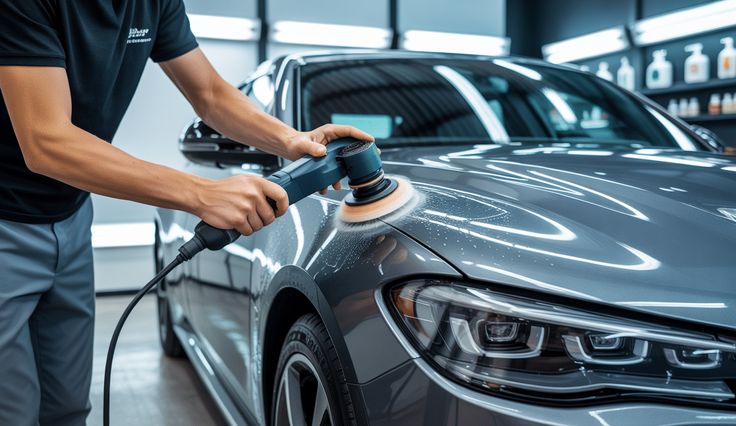In the ever-evolving world of automotive care, ceramic coating has emerged as a buzzword, promising unparalleled protection and a showroom shine for your vehicle. But what exactly is ceramic coating, and is it truly a worthwhile investment for your car? Let’s delve into the science, benefits, drawbacks, and ultimate value proposition of this popular Ceramic coating houston detailing treatment.
What is Ceramic Coating?
At its core, a ceramic coating is a liquid polymer that is applied by hand to the exterior of a vehicle. Unlike traditional waxes or sealants that sit on top of the paint, ceramic coating forms a chemical bond with the factory paint (specifically, the clear coat) upon application. This creates a new, semi-permanent layer of protection that is significantly more durable than conventional car care products.
The primary active ingredient in most ceramic coatings is silicon dioxide (SiO2), often combined with other elements like titanium dioxide. When cured, this solution creates a hydrophobic (water-repelling) and highly resilient layer that shields the underlying paint from various environmental contaminants and minor abrasions.
How Does It Work?
Once applied and cured, the ceramic coating forms a hard, glass-like shell over your car’s paintwork. This shell fills in the microscopic pores of the clear coat, creating an incredibly smooth and slick surface. This smoothness is what gives it its renowned hydrophobic properties, causing water to bead up and roll off the surface, carrying dirt and grime with it.
Benefits of Ceramic Coating for Your Car
The popularity of ceramic coatings stems from a range of compelling advantages:
- Superior Paint Protection:
- UV Ray Protection: Ceramic coatings act as a shield against harmful UV rays, preventing paint oxidation and fading over time.
- Chemical Stain Resistance: They create a barrier against acidic contaminants like bird droppings, tree sap, and acid rain, which can etch into unprotected paint.
- Protection from Environmental Fallout: Industrial fallout, road grime, and other pollutants struggle to bond with the slick surface.
- Enhanced Aesthetics:
- Deep, High Gloss Finish: Ceramic coatings significantly enhance the paint’s gloss and depth, giving your car a rich, “wet look” that often surpasses what wax can achieve.
- Hydrophobic Properties & Self-Cleaning Effect: The water-repelling nature makes water bead and roll off, carrying dirt with it. This means your car stays cleaner for longer and is much easier to wash.
- Long-Lasting Durability:
- Unlike waxes that last weeks or months, professional-grade ceramic coatings can last anywhere from 2 to 5 years, or even longer, with proper maintenance. This long lifespan is a major draw.
- Easier Maintenance:
- Because dirt and grime have difficulty adhering to the coated surface, cleaning becomes significantly easier and faster. Less scrubbing is required, and often a simple rinse and gentle wash can restore the shine.
- Preservation of Resale Value:
- A car with well-maintained paint and a protected finish will generally command a higher resale value. Ceramic coating helps keep your car looking newer for longer.
Drawbacks of Ceramic Coating
Despite the many benefits, ceramic coating is not a magic bullet and comes with its own set of considerations:
- High Initial Cost:
- Professional ceramic coating services can be a significant upfront investment, ranging from PKR 15,000 to PKR 90,000 or more in Pakistan, depending on the vehicle size, the quality of the coating, and the prep work involved. This is considerably more expensive than a traditional wax.
- DIY kits are available at lower prices (PKR 1,000 – PKR 20,000 for the product alone), but proper application requires skill and attention to detail.
- Extensive Paint Preparation Required:
- For the coating to bond correctly and achieve optimal results, the car’s paint must be meticulously cleaned, decontaminated (e.g., clay bar treatment), and often polished to remove any swirl marks, scratches, or imperfections. This prep work is crucial and accounts for a significant portion of the cost and time involved.
- Not “Scratch-Proof” or “Chip-Proof”:
- This is a common misconception. While ceramic coatings add a layer of hardness and can resist minor swirl marks from washing, they are not immune to deep scratches, rock chips, or dents. Your car can still get damaged.
- Professional Application Recommended (for best results):
- While DIY kits exist, achieving a flawless, durable finish often requires the expertise, specialized tools (like proper lighting), and controlled environment of a professional detailer. Improper application can lead to high spots, streaking, or reduced effectiveness.
- Water Spotting Can Occur:
- While hydrophobic, water that sits and dries on a ceramic-coated surface (especially hard water) can still leave mineral deposits (water spots). Regular washing and proper drying are still necessary to prevent this.
- Requires Maintenance:
- Ceramic coatings reduce, but do not eliminate, the need for regular car washing. Using pH-neutral car shampoos and proper washing techniques (like the two-bucket method) is essential to maintain the coating’s performance. Harsh chemicals or automatic car washes with brushes can degrade the coating.
Is Ceramic Coating Worth It for Your Car?
The answer to whether ceramic coating is “worth it” largely depends on your priorities, budget, and car care habits:
It is likely worth it if:
- You own a new or high-value vehicle: It’s an excellent investment to preserve its pristine condition and resale value.
- You want long-term protection: You prefer a durable solution that lasts years rather than reapplying wax every few months.
- You value a consistently clean and glossy car: The self-cleaning effect and enhanced shine are significant benefits.
- You want easier car maintenance: While not maintenance-free, cleaning becomes much less effort.
- You live in an area with harsh environmental conditions: UV, acid rain, or industrial fallout.
It might NOT be worth it if:
- You’re on a very tight budget: The initial cost can be prohibitive compared to waxes.
- You plan to sell your car within a year or two: You might not fully recoup the investment.
- You don’t mind frequent waxing and detailing yourself.
- Your car’s paint is already heavily damaged or oxidized: Extensive paint correction is needed before coating, adding to the cost.
In conclusion, ceramic coating is a significant leap forward in automotive paint protection. It offers a durable, long-lasting shield that enhances aesthetics and simplifies maintenance. While it’s an investment and not a magic solution to all paint damage, for car owners who prioritize maintaining their vehicle’s appearance and protecting its paintwork for years to come, a professionally applied ceramic coating can be a highly worthwhile endeavor.








